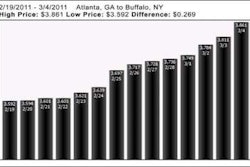The Port Authority of New York and New Jersey announced that cargo volumes at the port rose 16 percent in 2010. Port officials say the numbers are an encouraging sign of growth but still have not risen to the peak cargo container traffic levels reported in 2007 before the global economic downturn.
During 2010, the Port of New York and New Jersey reported that total container traffic was 5,292,020 loaded and empty TEUs (20-foot equivalent units) compared to 4,561,527 in 2009. The number of TEUs is slightly below the 5,299,105 in 2007, which was an annual record for the port.
Officials for the port – the largest on the East Coast and the third-largest in the United States behind Los Angeles and Long Beach – say they are continuing to project long-term modest annual cargo growth and are making the necessary infrastructure investments. The port, which handles about 31 percent of all East Coast cargo, will invest $283 million in 2011 to upgrade the port road network, enhance the existing ExpressRail system and continue its program to deepen the port’s channels to 50 feet.
The agency also has started the engineering and design work for a project to “Raise the Roadway” of the Bayonne Bridge to accommodate larger ships after the Panama Canal upgrades are completed in 2014. The agency also is continuing the development of the Global Container Terminal in Jersey City to accommodate future growth, upgrading and expanding the capacity of the cross-harbor rail float barge operation between Brooklyn and Jersey City, and planning to develop the Greenville Yards in Jersey City.
However, port officials say the limited increase in revenue generated by the increase in cargo volumes does not cover the costs of the port’s annual state of good repair, nor does it cover all of the capital improvements needed to maintain the port’s competitive position. “In this economic environment, the competition for port business is fierce,” says Chris Ward, Port Authority executive director. “That is why we continue to take steps with our industry partners to improve our port infrastructure to ensure we remain a national and global leader in port commerce.”










